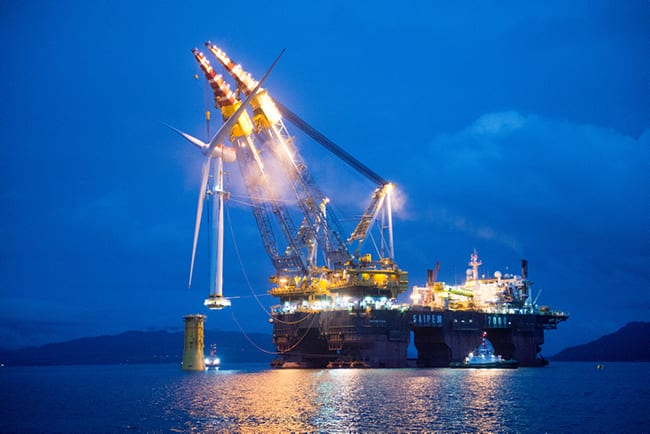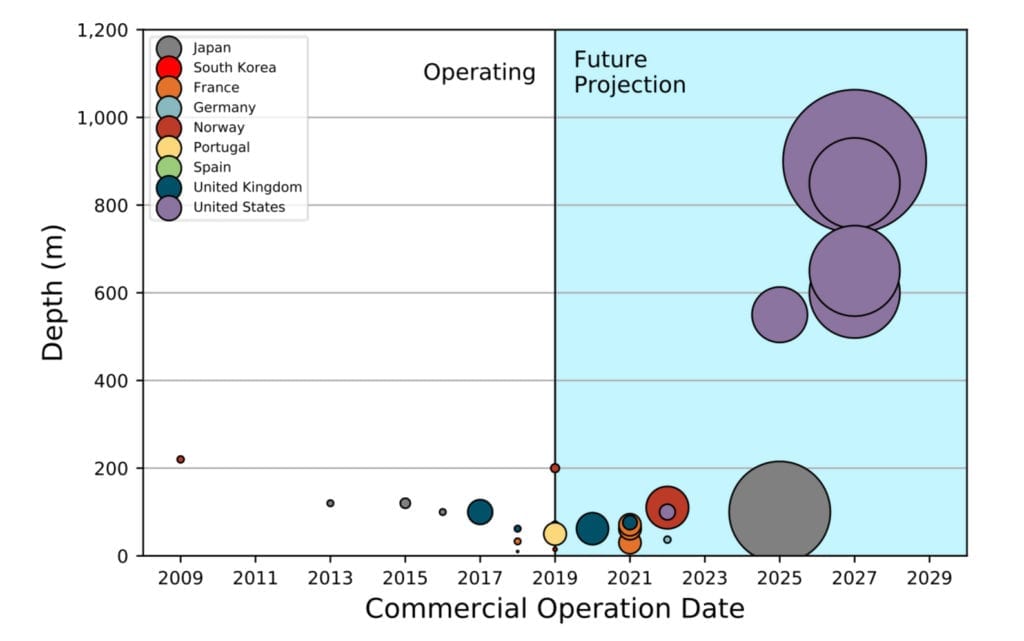First Floating Offshore Wind Farm to Power Oil and Gas Platforms Kicks Off
Credit to Author: Sonal Patel| Date: Thu, 31 Oct 2019 14:52:16 +0000
The post First Floating Offshore Wind Farm to Power Oil and Gas Platforms Kicks Off appeared first on POWER Magazine.
Siemens Gamesa has bagged a lucrative contract to supply 11 8-MW offshore wind turbines to Equinor’s 88-MW Hywind Tampen floating wind farm, a first-of-its-kind project that will power oil and gas platforms 140 kilometers offshore Norway.
Equinor—as Statoil, Norway’s state-owned oil company, is now named—announced a final investment decision to build Hywind Tampen on Oct. 11. The floating wind farm will be located in waters 260 meters (m) to 300 m deep between the Snorre and Gullfaks oil and gas platforms in North Sea. The wind farm is expected to meet about 35% of the annual power consumption from the five platforms: Snorre A and B, Gullfaks A, B and C.
Norway’s recent consent to extend the productive life of the Gullfaks field to 2036 and the Snorre field to 2040—up to 20 years longer than when the fields were initially planned—was essential to realizing the Hywind Tampen project. Total investments in Hywind Tampen will amount to about $544 million, with nearly half, $250 million, coming from Norway’s government, Equinor said.
A Hywind Floating Offshore Wind Expansion
For Siemens Gamesa, which will supply the wind farm’s 11 SG 8.0-167 DD turbines, the project poses a lucrative opportunity to gain a strong foothold in the burgeoning floating offshore wind market. “Thanks to our strong collaboration and joint focus on innovation, we are now at the forefront of developing this exciting technology and unlocking the vast potential for floating offshore wind power,” said Andreas Nauen, CEO of the Siemens Gamesa Offshore Business Unit, in an Oct. 31 statement.
Siemens Gamesa and Equinor worked together on the world’s first full-scale floating wind turbine project, the Hywind Demo, which was installed in Norwegian waters in 2009. (The project earned a POWER Top Plant award.) The two companies expanded those efforts to put online the 30-MW Hywind Scotland wind farm in 2017—a project that remains the world’s only commercially operating floating offshore wind farm. That pioneering project is now also testing a new battery system installed by Masdar and Equinor to evaluate the capabilities of advanced storage technologies.

The Hywind Scotland project comprises five 6-MW Siemens Gamesa turbines. This image shows the turbines being installed on floating foundations in Stord, Norway. Courtesy: Siemens Gamesa
Siemens Gamesa said the floating foundations in the Hywind Tampen project will be ballast-stabilized and anchored to the seabed with mooring lines. “With their lightweight nacelles, Siemens Gamesa large direct drive wind turbines are particularly suited for floating foundations,” it added. “The Hywind Tampen project continues this partnership, bringing industrial-scale floating wind a giant leap forward.”
A Burgeoning Floating Offshore Wind Market
According to the U.S. Department of Energy’s August 2019–issued 2018 Offshore Wind Technologies Market Report, the world’s floating wind energy project pipeline reached 4.9 GW in 2018. About 46 MW from eight projects are operating, but all are demonstrations except the 30-MW Hywind Scotland project. Of the eight floating offshore wind farms installed around the world, five (37 MW) are in Europe and three (9 MW) are in Asia, mostly Japan.
However, the DOE says an additional 14 projects representing about 200 MW are currently under construction or have achieved financial close or regulatory approval. In total 38 projects have been announced worldwide.

Global floating offshore wind pipeline. The world’s floating offshore wind market evolved from small-scale, single-turbine prototypes (2009– 2015) to multi-turbine demonstration projects (2016–2022). Post-2022, the first large-scale floating projects are expected to become commercially viable. Source: DOE, 2018 Offshore Wind Technologies Market Report.
The DOE also suggested that a number of major developments and trends in 2018 indicate growth of global offshore wind market is poised to accelerate. It predicted growth will continue to be driven by “the prospect of accessing a much larger resource area with high-quality wind resources, but in water depths that are too deep (nominally greater than 60 meters) for conventional fixed-bottom technologies.” In the U.S., more than 58% of the total technical offshore wind resource is located in water depths greater than 60 m, and in Europe that number is 80%, it said.
Meanwhile, initial pilot and demonstration projects have validated functionality of floating technologies and encouraged further turbine upscaling. “Similar to fixed-bottom technologies, floating systems seek larger turbines to help lower project costs,” said the DOE. Along with Equinox’s Tampen project, for example, Principle Power plans to use 8.4-MW MHI Vestas turbines on its tai-hull asymmetrical semisubmersible substructures at its 25-MW WindFloat Atlantic project in Portugal, That project is expected to reach financial close and begin construction later this year, pending government approval.
The DOE also suggested interest in floating offshore wind off the West Coast is surging, as evidenced by two unsolicited applications recently filed with the U.S. Bureau of Ocean Energy Management: the 150-MW Redwood Coast Energy project, and the 1-GW Castle Wind project. It is also closely watching developments in Japan—where Equinor Hitachi is seeking permitting for a 400-MW project—and in South Korea, which has two 200-MW floating wind projects in planning.
Equinor said it is eyeing these same key markets for its Hywind offering. “Estimates show that the technical potential for floating wind power is 6,959 GW for Europe, U.S., and Japan combined. Of high potential markets, we believe Japan can have 3.5 GW installed by 2030, followed by 2.9 GW in France, 2 GW in the U.S. and finally 1.9 in Ireland/UK.”
Siemens Gamesa, too, noted floating offshore wind’s vast potential. “Offshore wind already has a strong foothold in Europe with close to 18.5 GW installed capacity, and global potential to reach more than 100 GW by 2030. Of this, floating offshore wind is estimated to constitute 10% of the market, potentially powering 12 million homes in 2030,” it said.
As Eldar Sætre, president and CEO of Equinor ASA, noted in an Oct. 24 statement, Equinor’s offshore wind stakes have leaped in recent months. “The last few months have been a game-changer for our offshore wind business. Together with SSE, we were the winning bidder with three projects at Dogger Bank in the UK, making it the largest offshore wind farm development in the world. In addition, we won the opportunity to develop Empire Wind offshore New York, delivered development plans for Hywind Tampen and realized significant value from the farm-down in the Arkona wind farm offshore Germany,” he said.
—Sonal Patel is a POWER senior associate editor (@sonalcpatel, @POWERmagazine)
The post First Floating Offshore Wind Farm to Power Oil and Gas Platforms Kicks Off appeared first on POWER Magazine.